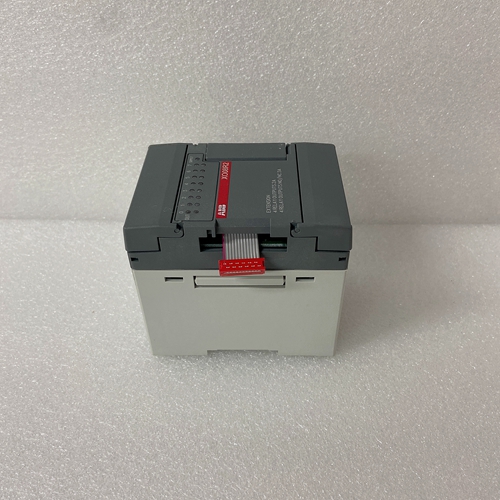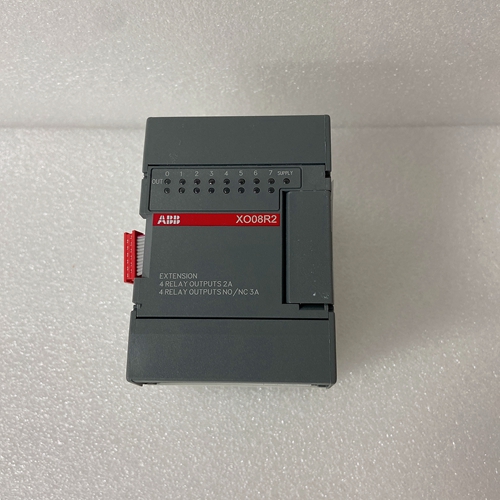
1SBP260109R1001数控系统模块
差分接收器的输入电压施加到精确的12位模数(a/D)
转换系统。A/D转换系统由微处理器读取,速度为250µs
对于转矩(电流)回路运行模式,每62.5µs一次。基于编码器的单元具有:
双增益(ANDG)输入的额外好处。启用时,系统使用两个14位A/D
读取用户提供的模拟信号的输入。一个输入是±10V信号的直接读数,而另一个包含2x增益项。当输入电压于4V时,2x通道用于确定用户的输入电压。这将分辨率扩展到15位等效值。在4V以上
系统使用直接14位转换。特殊的软件算法用于最小化交叉失真并增加0.25V滞后。
模拟系统通常需要缩放和偏移偏置。SERVOSTAR CD Lite添加了模拟偏移
(ANOFF1)变量,执行模拟死区(ANDB)调整,并对其进行缩放
通过速度回路输入缩放(VSCALE)或扭矩回路输入缩放数据发送到所选控制回路。模拟输入(ANIN1)变量表示以下模拟读数:偏移(ANOFF1)和死区(ANDB)调整,但在循环缩放之前。ANIN1可变范围为±22500计数(或mV)。
SERVOSTAR CD Lite还具有自动模拟输入调零功能。调用ANZERO
在驱动器启用或禁用时,命令在32毫秒内采样电机速度并更新
从而抵消模拟输入偏移。
此命令使用内部偏移
具有比ANOFF1更精细分辨率的机制能够提供远程启用输入(远程)
光隔离远程启用输入(远程)提供硬件驱动启用开关。这是12-24
VDC输入禁用或启用电机的功率级输出。必须向客户提供信号,以使驱动器启用(结合其他参数;激活)并运行。
不建议从逻辑电源(C5)上分接信号。此开关的切换也启动从故障状态恢复的尝试。
故障输出继电器(继电器、继电器模式)
SERVOSTAR CD Lite以继电器(继电器)的形式提供驱动器就绪/驱动器上升输出
输出继电器(继电器)输出由SERVOSTAR CD Lite的微处理器控制。那里是一个软件开关(RELAYMODE),用于将继电器(继电器)输出配置为“驱动器就绪”或“向上行驶”指示灯:如果RELAYMODE=0,则当驱动器无错误并准备运行时,继电器关闭。这是一个“驱动器”“就绪”配置。
如果继电器模式=1,则继电器仅在驱动器启用时闭合。这是一个“开车上路”配置(活动等于1)。
如果RELAYMODE=2不适用于CD-LITE。
如果继电器模式=3,则继电器在没有故障时打开,当驱动器检测到过错The input voltage from the differential receiver is applied to a precise 12-bit Analog-to-Digital (A/D) conversion system. The A/D conversion system is read by the microprocessor, 250µs for the velocity loop mode, and every 62.5µs for the torque (current) loop mode of operation. Encoder-based units have the additional benefit of a Dual Gain (ANDG) input. When enabled, the system uses two 14-bit A/D inputs to read the user-supplied analog signal. One input is a direct reading of the ± 10V signal, while the other incorporates a 2x gain term. When the input voltage is less than 4V, the 2x channel is used to determine the user’s input voltage. This extends the resolution to a 15-bit equivalent. Above 4V, the system uses the straight 14-bit conversion. Special software algorithms are used to minimize cross-over distortion and add 0.25 V hysterisis. Analog systems often require scaling and offset bias. The SERVOSTAR CD-Lite adds an analog offset (ANOFF1) variable to this reading, performs an analog deadband (ANDB) adjustment, and scales it through velocity loop input scaling (VSCALE), or torque loop input scaling (ISCALE) before passing the data to the selected control loop. The analog input (ANIN1) variable indicates the analog reading after the offset (ANOFF1) and the deadband (ANDB) adjustments, but before the loop scaling. The ANIN1 variable range is ± 22500 counts (or mV). The SERVOSTAR CD-Lite also has an automatic analog input zeroing function. Invoking the ANZERO command while the drive is enabled or disabled samples motor velocity over a 32 ms period and updates ANOFF1 accordingly to cancel out analog input offset. This command uses an internal offset mechanism that has finer resolution than ANOFF1 is capable of providing Remote Enable Input (REMOTE) The opto-isolated Remote Enable input (REMOTE) provides a hardware drive enable switch. This 12-24 VDC input disables or enables the power stage output to the motor. The signal must be customersupplied to get the drive to enable (in combination with other parameters; ACTIVE) and operate. Tapping the signal off the logic supply (C5) is not recommended. The toggling of this switch also initiates an attempt to recover from a fault condition. Fault Output Relay (RELAY, RELAYMODE) The SERVOSTAR CD-Lite provides a drive ready/drive up output in the form of a relay (RELAY) output. The relay (RELAY) output is controlled by the SERVOSTAR CD-Lite’s microprocessor. There is a software switch (RELAYMODE) that configures the relay (RELAY) output to act as a ‘Drive Ready’ or ‘Drive Up’ indicator: If RELAYMODE = 0, the relay is closed when the drive is error free and ready to run. This is a ‘Drive Ready’ configuration. If RELAYMODE = 1, the relay is closed only when the drive is enabled. This is a ‘Drive Up’ configuration (ACTIVE equals 1). If RELAYMODE = 2 is not avalible with CD-LITE. If RELAYMODE = 3, the relay is open when no faults are latch and closed when the drive detects a fault.










